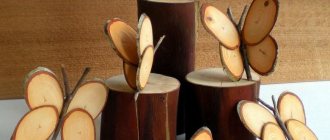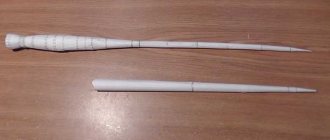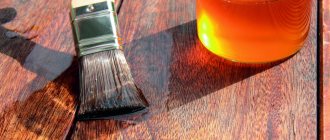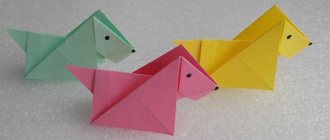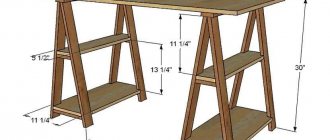Cars, airplanes, boats - these toys will never lose popularity among boys. Making a model of a ship with your own hands is not difficult, if you have a few sheets of corrugated cardboard (or unnecessary boxes) on hand and dad as an assistant. Well, our website can help with this. Today we will try to make the dreams of many boys of a real ship, albeit made of cardboard, come true.
To work you will need tools and materials:
- a sheet of double-layer corrugated cardboard 4 mm thick (the size depends on the desired dimensions of the finished vessel);
- a sheet of corrugated cardboard 2 mm thick (you can use unnecessary boxes, for example, pizza boxes);
- regular cardboard for sails;
- pencil;
- scissors;
- heat gun;
- Super glue;
- acrylic paints or gouache;
- empty egg carton;
- nylon thread.
You will also need to protect the surface, since we will be working with sharp and hot objects. A special polyurethane mat with markings will do.
Making a paper boat
This trick is familiar to every one of our compatriots whose childhood and youth occurred during the Soviet years. Having reached the present day, a paper boat can push its creator to new, more complex experiments.
In the meantime, it’s worth practicing on paper:
- An A4 sheet is folded in half twice;
- The resulting segment is unfolded once to bend 2 corners towards the center to form a pyramid with a rectangular protrusion;
- The outer side of the protrusion is turned outward so that its corners can be bent into a triangle;
- The inner side of the protrusion is also wrapped, and the corners are bent;
- The resulting triangle needs to be pushed inward to get a flat square;
- Both sides of one half of the square are folded over the other to form an accordion triangle;
- The previous action must be repeated, and then take the ends and unfold the finished ship.
Knowing how to make a ship out of paper, you can move on to more interesting designs.
Details
Add a few more details to the sides of the ship: small strips of cardboard that cover the “seams”:
We also cut out round portholes in the form of a torus with a diameter of 2.5-3 cm (inner diameter 1 cm).
You can also add more square windows.
Making a boat from cardboard
The previous paper model, despite the simplicity of its manufacture, quickly gets wet and loses its ability to float. Also, paper has a lower density compared to cardboard.
Because of this, the latter is more relevant in children's shipbuilding. In addition, cardboard allows you to make a more believable sailboat:
- The lines of the future walls and bottom of the ship are marked on a cardboard sheet (the first should be three - two side ones with a sharp tip and a rear side in the form of a rectangle or square);
- The fragments are cut out and glued to each other using hot glue;
- Inside the structure, you can arrange a two-level “rowing can” for installing a mast.
A toothpick will do as the last one. But how can you make a cardboard ship with a sail so that the design resembles a Viking longship?
First you need to make a cross from two toothpicks. Next, insert a sheet of paper from the bottom of the mast and bring the latter to the horizontal beam.
It is also recommended to complement the mast with a flag, and the nose with a dragon face made of cardboard. But then you will have to attach a tail to the back of the ship for its stability.
Ship's skeleton - operating procedure
We use hot melt glue for gluing; of course, adults will use this tool.
So, parts A, B, C, D, E are parts of the central part of the ship. Parts 1, 2, 3, 4, 5 are “stiffening ribs” and they must be glued perpendicular to the central parts (marked in different colors in the first picture).
The orange bottom piece serves as the base for the entire ship.
Green pieces a, b, c, d are the modules that make up the deck of the ship and are glued on top of everything.
If you have difficulties assembling the model from parts, refer to the first template, which indicates which parts of the ship should be attached where.
Now let's move on to forming the side part of our vessel. We cut strips 15 mm wide from thinner cardboard. The length of the strips depends on the length of the entire vessel (can be measured from bow to stern).
Each subsequent strip is glued on top of the previous one so that there are no gaps.
We have an almost finished ship: the side part looks so much like old boards!
Using the green template parts a, b and d, we outline the railing (top view, see photo). The width is 15 mm, but they can be made wider or narrower. These parts should be thicker, so we cut out 2 upper and lower parts and glue them together.
The balusters at the railing are small narrow strips measuring 30x5 mm, glued together in 3 pieces.
There should be 4 parts of the railing in total: 1 triangular - this is the bow of the ship, two on the sides and 1 in the form of a trapezoid - at the stern of the ship. We fix the railing parts to the frame of the ship with glue.
Making a boat from wine corks
A sailboat made from wine corks can be a good alternative to the above designs. To make such a boat, it is enough to have:
- Three plugs;
- Nylon thread;
- Toothpick;
- Colored paper.
Using a gypsy needle, you need to make holes through the plugs so that the latter can be connected to each other with a nylon thread. A toothpick with a sail made of colored paper is stuck into the middle cork and the boat is ready.
Sail
Before we deal directly with the sails, we need to make a base for them - the masts. Let's roll three corrugated cardboard tubes and glue them together. The middle mast is the highest, its length will be about 36 cm, the front one - 32 cm, the third - 22 cm.
Sail details:
- 1a and 1b for the front;
- 2a and 2b are slightly larger and for a medium mast;
- 3a for the third mast.
To give the sails a more believable curved shape, you can glue two pieces of corrugated cardboard and regular cardboard and, while the glue is hot, give them the desired shape.
We glue the edges of the sails with small strips (these will be the yards) and fix them with glue on the mast. Now all that remains is to imitate the ropes that secure the sails to the ship. We use superglue for them (it will glue the threads more delicately and thinly). If you have difficulties with where and what threads to glue, you can turn to any source on the Internet.
Making a boat from a matchbox
This method answers the question of how to make a ship with your own hands so that the design resembles a modern steamship.
To do this, you will also have to arm yourself with cardboard and colored paper:
- First, a frame is made like that of a drakkar;
- The walls and bottom are glued together, and a matchbox is placed inside the boat;
- A small tube is cut out of colored paper to simulate a steam pipe.
Instead of a tube, you can insert a barbecue skewer into the box. If it is located on the bow, then a thread can be drawn from it to the mast. You will need thread to plant flags made of multi-colored paper.
Peculiarities
Making a sailing ship out of wood with your own hands is quite a labor-intensive task. You will need knowledge and a certain skill. You will also need to be patient. But the end result will definitely repay all the effort.
A handmade vessel will not only be a source of pride for you, but also an excellent element of interior decor in a nautical style.
Making a boat from foam plastic
Lightweight ball-shaped material can serve as the basis for the frame. Foam plastic is cut well, which gives the young designer the opportunity to experiment with shapes.
And don’t ask yourself how to make a spaceship? It is enough to find a large piece of foam plastic to cut out the desired design from it, guided by the impressions of watching “Star Wars” or “Starship Troopers”.
The finished spaceship can be launched. And if it exactly repeats the design of the muse, then it belongs on the shelf next to ships in a bottle. By the way, foam plastic can be painted, which is good for young artists.
Necessary materials
The photo of a ship made of wood, made by yourself, shows that the following materials can be used for its manufacture:
Tree. It can be represented by such soft and non-fibrous species as cedar, linden, and walnut. Area of application - creating the main parts of a ship or small detail elements. Requirements for wood - evenness of surfaces, absence of knots and defects.
Plywood. The most popular material for shipbuilding. Usually the balsa or birch type is used, since they give the least amount of chips when sawing. The standard sheet thickness is considered to be 0.8 - 2 mm.
Veneer. Externally, these are thin plates of natural wood of valuable varieties. Used to decorate surfaces made of cheap materials.
Also, when creating models of merchant and military ships from wood with your own hands, you cannot do without such fasteners as thin chains, laces, threads, small nails made of brass and copper, etc. gizmos.
It’s also worth purchasing high-quality wood glue, sets of cardboard and tracing paper. Tiny detailing elements are made from metal casting or polymer clay.
Note!
- How to make wooden shelves with your own hands - original design options
Kinusaiga technique for beginners: what is it, a description of creating paintings from threads
How to weave a figurine from rubber bands: how to learn to weave animals, toys and what you can make from rubber bands on a slingshot
Making a combined boat
After reviewing models made of cardboard, cork, matchbox and foam, it is worth thinking about combining the appropriate materials:
- Cork - suitable for rounded shapes that are inherent in guns;
- Polystyrene foam – relevant for cutting out the side part;
- Matchboxes - well imitate the crew's interior;
- Cardboard is suitable for creating complex figures like sailors.
The appropriate combination serves as an excellent replacement for an expensive construction set.
Having created a ship from improvised materials, a child will not soon ask how to make a ship from Legos so that it resembles a combat one.
In any case, the store design does not stand well on the water, which cannot be said about the thematic analogue.
Advantages of sailboat crafts
Creating homemade ships has the following positive aspects:
- development of fantasy and imagination;
- stimulation of fine motor skills;
- low financial costs;
- the opportunity to independently make a handmade interior accessory.
In addition, it is worth noting the environmental friendliness and safety of the source material for modeling.
In conclusion, it must be said that a suitable do-it-yourself drawing of a wooden ship can be found on the Internet without any problems. This fact makes the creation of frigates and galleys possible even for beginners.
The main thing to remember is that you need to be patient and follow the chosen instructions exactly. Then, without a doubt, everything will work out.Photo tips on how to make a ship
Origami boat
Like a paper airplane, the production of the boats that Soviet children launched on the water involves the use of origami techniques, but in those distant years, of course, no one had heard of this. As you might guess by looking at the photo of the finished boat, to make it using the origami technique we only need a piece of paper.
You can use regular office paper the size of a landscape sheet or use a notebook sheet. The photo in front of you clearly and simply illustrates the step-by-step assembly of the toy.
The paper craft is strong enough to withstand a load like little plasticine men or Kinder Surprise toys.
Putting a boat on the water, populated by sailors, or maybe pirates, is an exciting process that a little person will remember for a long time. On a white ship (it is assumed that your craft is made of white paper), draw windows and different parts of the ship such as the hold, rudder, stern, deck boards, attach a plasticine anchor, attach a flag made of colored cardboard or paper to a toothpick. Name these elements out loud to further develop your child's curiosity.
From a plastic bottle
Additionally, you will need a plastic bottle (a yogurt box, juice box, or plastic canister will do).
- Approximately 5 cm away from the bottom of the bottle, use a stationery knife to make an incision approximately to the middle of the bottle.
- You will need to retreat a little less from the neck. An incision is also made to the middle.
- The notched part is removed, and a foam base for future equipment (masts, anchors, etc.) is installed in the remaining part, which has become the hull of the vessel.
- Masts with sails are installed. You can add an anchor and ropes.
Model No. 1: Boat
- Take a sheet of A4 size office paper. It is rectangular, but this model requires a square. Place the sheet vertically. Take the upper right corner with your right hand and bend it down until the top side of the sheet coincides in line with the left side. Press the corner firmly and straighten the diagonal. We get a double triangle.
- There is an extra rectangular area under the triangle that needs to be removed. To do this, use scissors or cut with a knife using a ruler.
- We open the double triangle and get a square.
- Fold it in half along the horizontal axis. We get a double rectangle. Let's expand it.
- We bend each rectangle in half inward, towards the central horizontal line.
- We bend what happened again in half along the horizontal line. Now we have a narrow double rectangle. We position it so that it opens from the top.
- Fold the bottom left and right corners of the rectangle up. They should not reach the top edge by about 15 mm. We get a rectangle with corners turned up and a narrow double stripe at the top.
- From this strip you need to form the sides of the boat. To do this, divide each strip in half lengthwise and bend it down along this line 2 times.
Attention! Our strip (side) should press the 2 corners bent up. This is the weak point in this model! You can lightly glue the corners and strip with glue to strengthen the structure.
- We turn our product over to the other side and form the second side by folding the upper open edge of the rectangle down 2 times. The boat is almost ready!
- It is necessary to form the keel of the boat on which it will stand. To do this, bend the lower, closed part upward by about 10 mm. Unbend.
- Turn it over to the other side and bend it up again by 10 mm. Unbend. We now have lines along which we will set the keel inward.
- We stretch the sides in different directions and set the sharp keel inward, creating the bottom of the boat. This will give her stability. The boat is ready to sail!
Assembly sequence
Work must be carried out in the following sequence:
- First, we put transverse frames on the keel (longitudinal beam). At the bottom of each of them there is usually a groove for attaching to a plywood keel.
- To join, you can use standard glue, but you can use special adhesive mixtures that are intended for ship modeling.
- We fix the upper parts of the frames on the deck. For simple ship models, the deck consists of one sheet of plywood, while for complex ones it can be multi-level.
- After the glue has dried on the frames, you can begin covering the side with thin strips of plywood. The thickness of the material should not exceed 1.5 mm, since only in this case can you bend the skin without the risk of damaging it.
- To bend veneered plywood, it can be heated and moistened. After this, the material bends easily, and over time takes on a stable shape.
Final finishing
Once the case is assembled and dried, you will need to do the following:
- Make deck superstructures from thin plywood and secure them.
- The sides must be built up so that they protrude above the plane of the deck.
- We cover the surface of the deck with wooden veneer or line it with an awl, imitating plank cladding.
- Make and install all the small elements such as the steering blade and steering wheel.
- Attach the masts with additional devices (spars), set the sails and stretch the structure using rigging threads.
Finally, the plywood elements must be treated with stain and varnished. This will provide the souvenir with at least a couple of decades of complete preservation.
Crafts on the theme of the sea and the underwater world
Sea crafts give bright emotions and a rosy mood even in cold winter. If you are lucky enough to collect a collection of shells during your vacation, hurry up to become the authors of three-dimensional applications, paintings, frames, a marine theater or an aquarium.
- Sea treasures are easily transformed into beads, pendants and pendants.
- Cold porcelain and salt dough will help complement the composition with starfish, corals, and colored stones.
- The ocean in a bottle is an entire underwater world that allows you to come up with different stories and study marine life.
- On a cool day, boats made from scrap materials will also give you warm memories of summer.
Marine artwork
When making marine-themed decor, don’t limit yourself to anything - create, try, dare
When making products on the “sea” theme, you can use absolutely any natural material
Add a piece of the sea to your home
DIY souvenir boat
Every job must begin with preparation, and modeling is no exception. First you need to decide what you plan to build. If you have not encountered the art of ship modeling before, we recommend that you first find drawings of a plywood ship on the Internet: they usually contain the information you need and even a beginner can understand them.
On sale you can find ready-made kits that allow you to assemble a ship from ready-made parts. Beginners should be interested in such kits, although they are sometimes quite expensive. It is better to master the technology from the very beginning.
Print out the drawing and make templates for the main elements based on it. We transfer the templates to plywood, and then proceed to sawing.
How to make a rocket (spaceship) from plasticine
All boys are interested in spaceships, various types of technology, satellites, and in their hearts they dream of being astronauts. They want to see a real rocket, to get at least a glimpse of what is inside, how everything works there. Of course, parents buy them all kinds of toys, but how can they compare with real units of impressive size? But there is still a way to feel like spacecraft designers - by creating a small copy with your own hands. Every boy can make any model of a rocket from plasticine . This master class shows one of the options.
Materials that will be used in master classes
To work we need the following:
Paper
At first, anything will do: from a notebook sheet to an ordinary office one. But given that we will be making floating models, in the future it is better to take thicker paper, for example, drawing paper. There is also printing paper. It is used for the production of glossy magazines and geographical maps. Resistant to soaking and ideal for ships!
Tools
Scissors: needed to create a square sheet from a rectangular one. In the future, it will also be necessary to acquire a metal ruler, a stationery knife and a sharpened pencil of hardness T, 2T or TM (H, 2H, HB) for marking. This will immediately increase accuracy and precision, and the fold lines will be just perfect! Instead of a knife, some use a sharpened stick.
Observe safety precautions: a knife and scissors are not a toy!
PVA glue: some models have weak joints. We will strengthen them with gluing.
Workplace
You can, of course, fold the boat on your knee, but then you will get the appropriate quality. Organize your workplace: a table with good lighting!
Now that the organizational part is completed, let's get to work! Let's start from simple to complex. During the familiarization phase, we will not use bending tools when folding. This will reduce the time.
Model No. 2: Catamaran
The first steps of making this model are similar to the previous one.
- Let's make a square. For a description of how to do it, see the “Boat” instructions.
- Bend it in half along a vertical line. Let's straighten it out.
- Now we bend each half in half inward towards the central vertical line. Let's straighten it out.
- Rotate the sheet 90 degrees. We repeat all the operations: fold it in half along a vertical line. Let's straighten it out.
- We bend each half in half inward towards the central vertical line. Let's straighten it out. We should end up with a sheet divided into 4 large squares and 16 small ones. This is important to understand for further work.
- We make two large diagonals, folding our workpiece in half along them. Let's straighten it out.
- We look at the unfolded sheet. It is divided into 4 squares. In each of these squares you need to make diagonals.
- To do this, take each of the 4 squares by a corner and bend them diagonally inward, towards the center of the large square and straighten it.
- The result is a large square with diagonals, which consists of 4 smaller squares, also divided by diagonals.
- Fold the left and right halves of the workpiece in half inward, towards the vertical center line.
- We look at the vertical blank. It now consists of two squares: upper and lower. These are the two parts from which we will form the catamaran boats. We work with the bottom square.
Attention! Difficult moment! There are two corners located in the center of the lower edge of the rectangular blank. We pull them up one by one, towards the middle of the workpiece. We get a rhombus located at an angle downwards.
- The upper corner of the resulting diamond consists of two corners. We stretch them in different directions, while simultaneously lifting its lower corner up. It turns out to be a flat boat. Turn the workpiece 180 degrees.
- We repeat all the previous operations with the second half and get a second boat, symmetrical to the first.
- We bend the workpiece so that two boats are folded along a horizontal line.
- We straighten the sides of the boats. The catamaran is ready to sail!
And a bigger raft...
Great fun for older children is to build an almost real raft from sticks and twigs. The activity is not as simple as it might seem at first glance; In order for the raft to be stable, you must first make a rectangular frame, and then attach the platform sticks to it. Kids can work with sticks the size of their palm, but a group of boys at the dacha of primary school age can easily build a working model that can even withstand the shipbuilders themselves.
“Important: you can test it on people only in a small place and only under adult supervision!
Foam liner
Another environmentally flawed project: polystyrene foam cannot be left in the river! The fish are trying to eat it and this diet ends badly for them... But, if your child is responsible and careful, you can ask dad to saw down parts of the ship from unnecessary packaging: the bottom - in the form of an elongated pentagon and the side of the boat - frames of the same shape. By the way, even your mother can handle a small boat; a stationery knife will help you.
The most difficult moment is gluing the layers of foam. Moment glue and other adhesives containing solvents may not be suitable, so use regular PVA glue for crafts that will not be subject to heavy loads, or Styroglue, a special adhesive for ceiling tiles.
“If you applied glue to the parts, pressed them, but they did not stick, it is better to cut out the parts all over again; Dried glue significantly impairs the adhesion strength.
Bottom of a sailboat
How to make a ship out of plasticine? You need to start working with the body of the craft. To create a boat or the lower part of any boat, you can use the pattern given in the photo below. Such parts are rolled out on a board with a rolling pin. To prevent the plasticine from sticking to it and having to tear it off, place cling film under the workpiece. Next, the rolled sheet needs to be cut into three main elements: a small bottom of the vessel and two identical sides.
Then the parts along the edges are fastened with fingers, making tucks along the entire surface. Using your hands, smooth out the folds so that they are smooth. Further work remains on setting up the ship. Here you can already make a vessel for any purpose, if desired.

